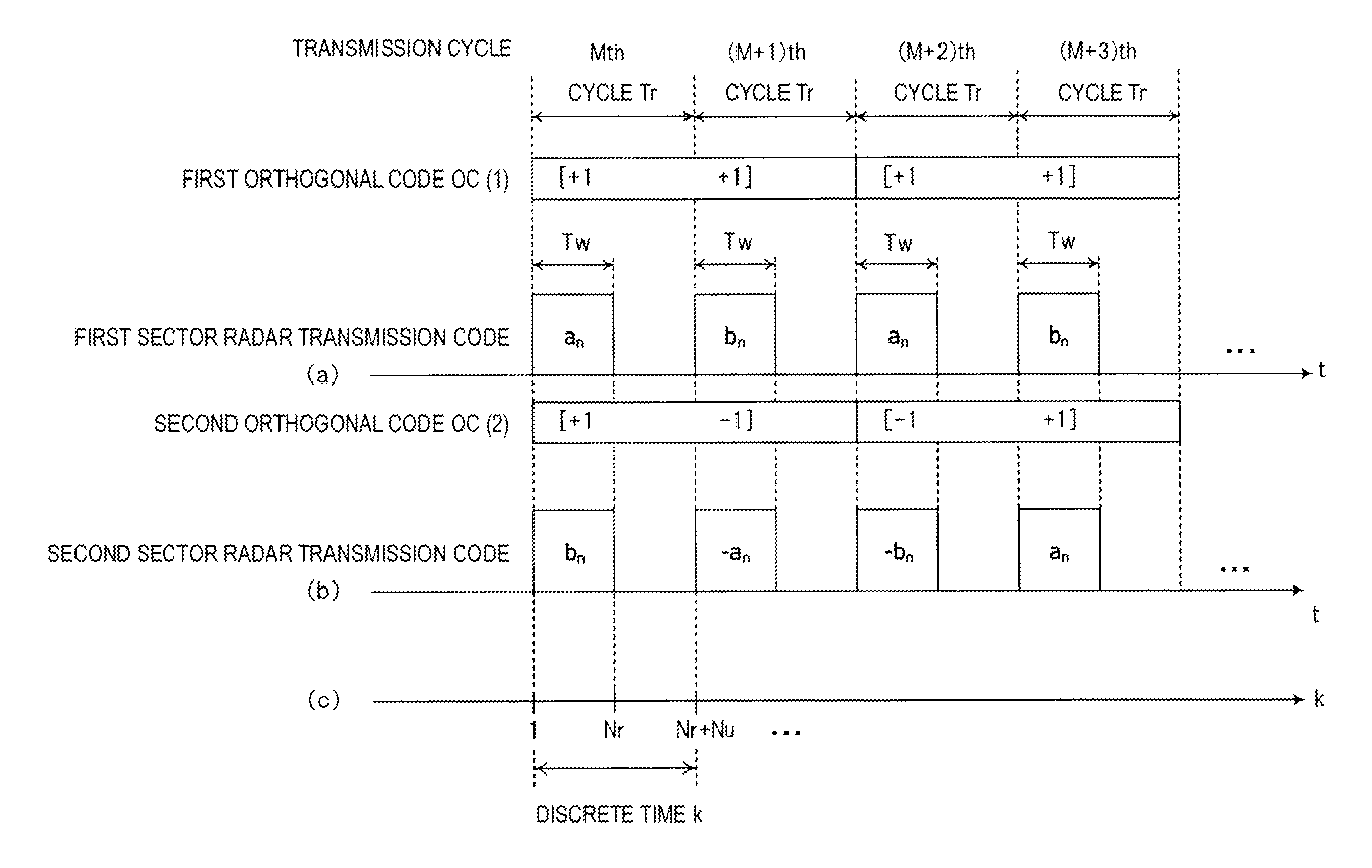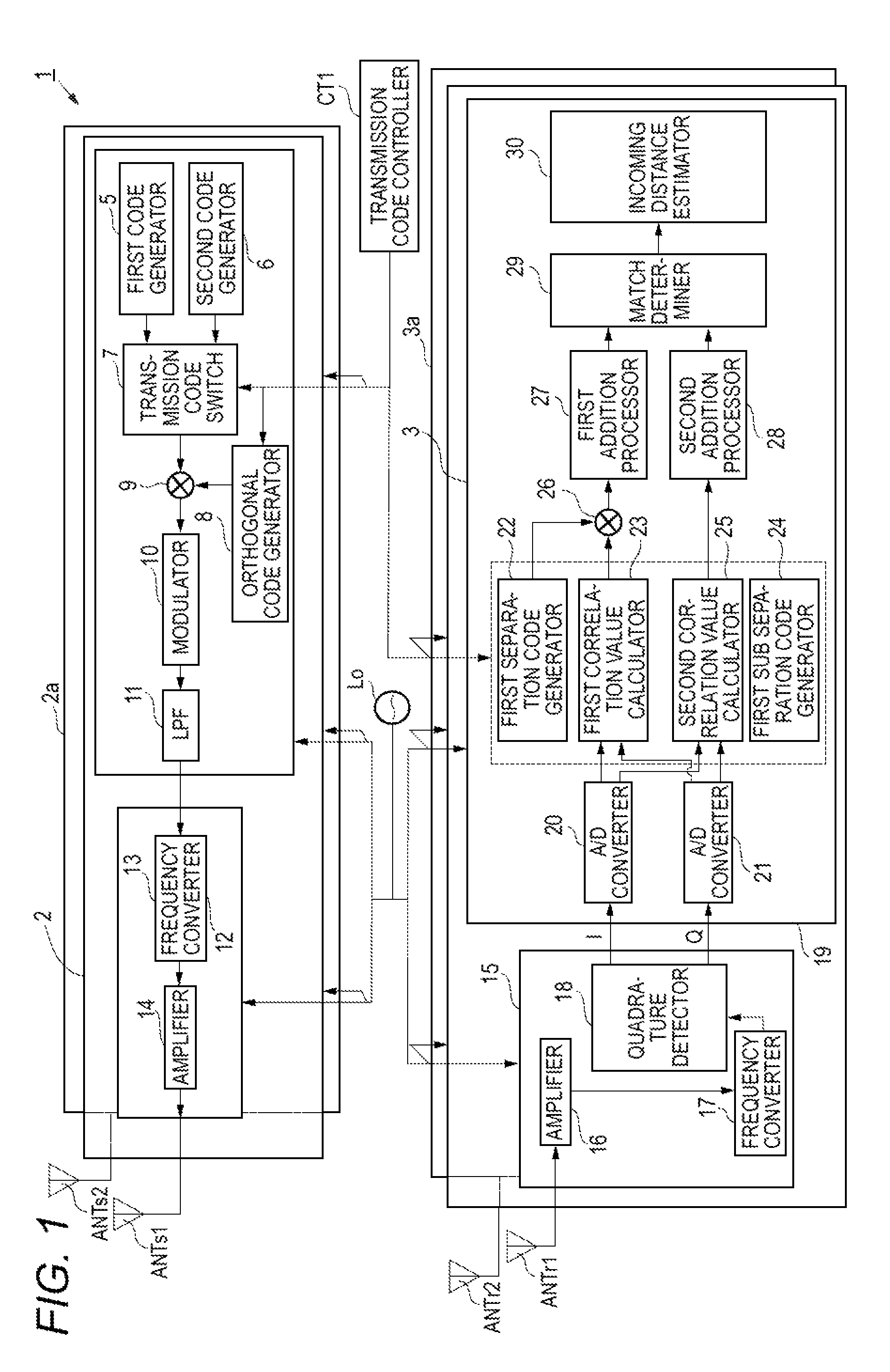Radar device
a radar and target technology, applied in the field of radar devices, can solve the problems of deterioration of detection accuracy of radar devices when they detect targets in a long distance, and large amount of frequency resources, so as to reduce interference and low range sidelobe characteristics
- Summary
- Abstract
- Description
- Claims
- Application Information
AI Technical Summary
Benefits of technology
Problems solved by technology
Method used
Image
Examples
first embodiment
[0060]A configuration and an operation of a wide area radar device 1 according to a first embodiment will be described with reference to FIG. 1 and FIG. 2. FIG. 1 is a block diagram illustrating an internal configuration of the wide area radar device 1 according to the first embodiment. FIG. 2 is a timing chart relating to the operation of the wide area radar device 1 according to the first embodiment. (a) in FIG. 2 is a diagram illustrating a first orthogonal code OC (1) and a transmission code of a first sector radar at each transmission cycle Tr, (b) in FIG. 2 is a diagram illustrating a second orthogonal code OC (2) and a transmission code of a second sector radar at each transmission cycle Tr, and (c) in FIG. 2 is a diagram illustrating the relationship between each transmission cycle Tr and a discrete time k.
[0061]As shown in FIG. 1, the wide area radar device 1 includes a reference signal oscillator Lo, a transmission code controller CT1, a first sector radar transmitter 2 to...
modification example 1
of the First Embodiment
[0240]The complementary codes an and bn having the code length L used in the first embodiment is obtained by recursive connection from sub codes that form a pair of complementary codes having a code length L / 2w. Thus, in a sub separation code subOC (q) generated according to code units en and fn having a code length L / 2w, the orthogonal relationship is obtained. Here, w represents an integer of 1 or more.
[0241]Accordingly, the wide area radar device according to Modification Example 1 of the first embodiment may generate a sub separation code using the pair of sub codes e and fn having the code length L / 2w that is a shorter code length, according to the movement speed of the target.
[0242]In this case, the second correlation value calculator of the wide area radar device performs a second correlation calculation in a unit obtained by dividing a portion corresponding to the transmission section Tw of the reference transmission signal r(k, M+p) by 2w as a referen...
modification example 2
of the First Embodiment
[0246]In the first embodiment, the wide area radar device 1 has the two sector configuration of the first sector radar and the second sector radar as shown in FIG. 1. A wide area radar device according to Modification Example 2 of the first embodiment further includes a third sector radar, and thus, has a configuration of total three sector radars.
[0247]FIG. 7 and FIG. 8 are timing charts relating to operations of the wide area radar device of Modification Example 2 according to the first embodiment. FIG. 7(a) and FIG. 8(a) are diagrams illustrating an orthogonal code OC (1) and a transmission code of a first sector radar at each transmission cycle Tr. FIG. 7(b) and FIG. 8(b) are diagrams illustrating an orthogonal code OC (2) and a transmission code of a second sector radar at each transmission cycle Tr. FIG. 7(c) and FIG. 8(c) are diagrams illustrating an orthogonal code OC (3) and a transmission code of a third sector radar at each transmission cycle Tr.
[02...
PUM
 Login to View More
Login to View More Abstract
Description
Claims
Application Information
 Login to View More
Login to View More - R&D
- Intellectual Property
- Life Sciences
- Materials
- Tech Scout
- Unparalleled Data Quality
- Higher Quality Content
- 60% Fewer Hallucinations
Browse by: Latest US Patents, China's latest patents, Technical Efficacy Thesaurus, Application Domain, Technology Topic, Popular Technical Reports.
© 2025 PatSnap. All rights reserved.Legal|Privacy policy|Modern Slavery Act Transparency Statement|Sitemap|About US| Contact US: help@patsnap.com



